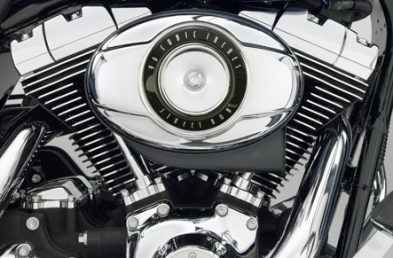A stroke is the action of a piston travelling the full length of its cylinder.
Step 1+2 (STROKE 1)
Step 3+4 (STROKE 2) Piston travels down the cylinder barrel Ignition & Exhaust The spark plug ignites the fuel/air mix in the cylinder, the resulting explosion pushes the piston back down to the bottom of the cylinder, as the piston travels down, the transfer port openings are exposed & the fresh fuel/air mix is sucked from the crankcase into the cylinder. As the fresh fuel/air mix is drawn into the cylinder, it forces the spent exhaust gases out through the exhaust port.
Two stroke engines are mainly used for scooters, cross bikes and R/C modelling, they also are used for the starter racing class where all Moto GP racers started from. That is due to the fact that 2 stroke engines deliver wide range of RPMs up to 20 000 and therefore power. They are not so widely used because they overheat, polute, and are not quite fuel friendly, infact they are very thirsty.
Two stroke engines are mainly used for scooters, cross bikes and R/C modelling, they also are used for the starter racing class where all Moto GP racers started from. That is due to the fact that 2 stroke engines deliver wide range of RPMs up to 20 000 and therefore power. They are not so widely used because they overheat, polute, and are not quite fuel friendly, infact they are very thirsty.
4-Stroke Engines
 Stroke 1 of 4 "Suck": On the intake or induction stroke of the piston , the piston descends from the top of the cylinder to the bottom of the cylinder, reducing the pressure inside the cylinder. A mixture of fuel and air is forced by atmospheric (or greater) pressure into the cylinder through the intake port. The intake valve(s) then close.
Stroke 1 of 4 "Suck": On the intake or induction stroke of the piston , the piston descends from the top of the cylinder to the bottom of the cylinder, reducing the pressure inside the cylinder. A mixture of fuel and air is forced by atmospheric (or greater) pressure into the cylinder through the intake port. The intake valve(s) then close.Stroke 2 of 4 "Squeeze": With both intake and exhaust valves closed, the piston returns to the top of the cylinder compressing the fuel-air mixture. This is known as the compression stroke.
Stroke 3 of 4 "Bang": While the piston is at or close to Top Dead Center, the compressed air–fuel mixture is ignited, usually by a spark plug (for a gasoline or Otto cycle engine) or by the heat and pressure of compression (for a diesel cycle or compression ignition engine). The resulting massive pressure from the combustion of the compressed fuel-air mixture drives the piston back down toward bottom dead center with tremendous force. This is known as the power stroke, which is the main source of the engine's torque and power.
Stroke 4 of 4 "Blow": During the exhaust stroke, the piston once again returns to top dead center while the exhaust valve is open. This action evacuates the products of combustion from the cylinder by pushing the spent fuel-air mixture through the exhaust valve(s).
The 4-Stroke engine is the widely used engine. It has four strokes which are produced with the help of valves, the four stroke engines can have 2,4,5 valves per cylinder or even other numbers. They are the most common engines and there is a big variety of 4-stroke engines
In-line 4 cylinder engine
This is a fresh example of the most commonly used engine among japanese bikes. That one is the Suzuki's 1000cc gsx-r engine.
they deliver plenty of power, are easily maintained, and have acceptable fuel consumption. They are also used in Moto GP, well infact the technologies are first used in Moto GP series and after that applied to the production bikes, which means that every new model is upgraded with the latest developments and that means POWEER. Well not only of course.
V-twin engine

These engines are commonly used for the types of bikes called choppers, like Harley Davidson for example, They put them also on Enduro bikes, rarely on sport bikes (KTM, Honda VTR and etc.)
Flat 6 engines
 Honda Motorcycle Japan Co. show off the EV06 concept bike during the official opening day of the 40th Tokyo Motor Show in Tokyo, back in 2007 . The EV06 features a liquid-cooled 4-stroke, 12-valve OHC flat 6 engine made its premiere during the show.
Honda Motorcycle Japan Co. show off the EV06 concept bike during the official opening day of the 40th Tokyo Motor Show in Tokyo, back in 2007 . The EV06 features a liquid-cooled 4-stroke, 12-valve OHC flat 6 engine made its premiere during the show.Also the flat six engines are used by Honda for their Famous Gold Wing model.
Mostly these flat engines or also called boxer engines are used by BMW on their motorcycles.
L-twin engines
 These engines are invented from Ducati and as on the example the engine is from a Ducati 999 and produces 140hp at about 9750 RPM.
These engines are invented from Ducati and as on the example the engine is from a Ducati 999 and produces 140hp at about 9750 RPM. These engines are basically a 90degree V-Twin engine.
The new Desmosedici uses L-quattro engine for example.

